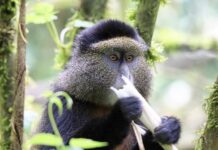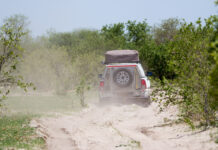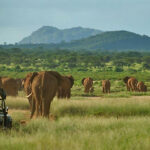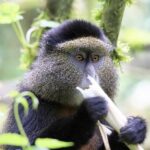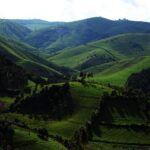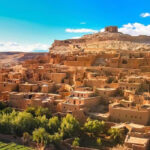Mamumu, despite perhaps your immediate reaction, is not a voodoo ceremony. It is a Community Based Organisation (CBO) based in three villages adjoining the northern edge of Kakamega Forest. They are called Mangang’a, Mukangu and Mungakha.
Luhya is the local language in Western Province and the little-known name of Kenya’s second largest ethnic grouping after the universally-known Kikuyu. In Luhya, Mangang’a means Hornbill, Mukangu is a tree from which wooden cooking spoons are made, and Mungakha is the aloe vera plant which grows in the eponymous village.
Mamumu is the creation of a singularly visionary and energetic man, Alphonce Muhambe Inyanza, who was brought up next to the forest before moving away, as is often the case, in search of opportunities. After working as a driver for expat researchers, he returned home after thirty years, and realised the uniqueness of Kakamega Forest. Also, critically, he noticed how much the boundary had been eroded and degraded during his time away. He foresaw that without vigorous action, the forest would shrink still further. Within ten years, Kenya’s last tropical forest, which had taken hundreds of thousands of years to develop, would vanish for ever.
The principal threat arises from felling trees illegally, removing them from the forest under cover of darkness, converting the timber into charcoal at home and then selling the charcoal as if it originated from peoples’ farms (shambas) instead of where it really comes from, the protected forest.
Alphonce drove a group of researchers connected with Nature Kenya around Mt Kenya and this led to that organization running an open day on the importance of the forest for hydrology and agriculture near Alphonce’s home. In response to Alphonce’s enthusiasm, he was equipped with a wheelbarrow,watering can and elementary advice to set up a tree nursery.
Alphonce then devised a coherent, comprehensive strategy to stem and then reverse the tide of deforestation. This entails
a) informing and educating the local community, to make his friends and neighbours as aware and concerned as he is about the long term consequences of destroying the forest.
b) taking action to replant indigenous trees in degraded parts of the forest, in families’ compounds and in public areas such as roadsides.
c) creating alternative sources of income to replace income from charcoal.
d) providing sources of employment for local unemployed young people, of whom there are increasingly many, due to the fragmentation of sustainable shambas into pocket sized parcels of land insufficient to grow food for a family continuing apace.
(This is the inescapable consequence of Kenya’s demographic time bomb because five or six sons and daughters each inherit a small portion of their parents’ estate. Very often such a small share will not provide enough food and will not be enough to keep the next generation occupied.)
Creating a residential centre for elderly without relatives so as to bring them together into one place to be occupied and cared for. It is paradoxical that this should be the case given the situation described above, but it is.
So Alphonce can see not only what needs to be done but how to do it. Not only that but he can see how the interests of all sectors of the community can be integrated and promoted by Mamumu, which maximises the local support base and therefore the chances of success with the core environmental imperative of preserving the forest in its own right and for future generations to enjoy and benefit from.
But how best to put this strategy into practice? Profile, publicity and resources were all required. The way to attract these was to set up a CBO, which can formalize the collective will, and provide a means to approach potential funders with a united voice and a structured, coherent programme. In August 2013, Alphonce established the CBO, obtained a vacant shop in the village of Ivakale as his base and set about spreading the word and recruiting supporters.
Eighteen months later he has attracted twenty five individuals and seven groups to join. Thus a good start has been made in achieving the critical first part of the strategy.
Fulfilling the second part of the strategy had started with the tree nursery training and also in the gift of a wheelbarrow and a watering can, to enable him to water the seedlings by trekking to and from the local river, the Isiukhu, carting the water in two 20litre plastic gerry cans. The next step was to approach the Kenya Wildlife Service (KWS) to seek permission to enter the forest to collect seeds and seedlings for propagation in the nursery. This was easily granted but thereafter the going became tougher, because Alphonce needed access to a water supply closer to the nursery, located in his garden, than the River Isiukhu, one km or half an hour’s walk away, if he was to have any chance of realising his vision of planting three million trees.
In order to secure funding for a borehole external funding was required. Alphonce’s first move was to approach the Ministry of Environment for Kakamega County. In May 2014, he invited the Minister to visit the area to see for herself what destruction was taking place. After seeing evidence of recently felled trees in the forest, she opened the premises Alphonce had rented as an office and shop window and expressed her support for the project.
Then she handed responsibility for taking it forward to her Head of Department. Nothing happened. There are rumours circulating that the borehole was approved for funding in the budget, but the funds were diverted by senior officers into their private bank accounts.
This is where we enter the story. When our agent took us to view the potential site for our lodge at the end of February, he took us first to meet Alphonce, whom he had previously approached to see if he knew of any suitable plots for our project adjacent to the forest. Before taking us to inspect the site, Alphonce told us the story of how he had set up the Mamumu CBO. During the course of the morning, Alphonce elaborated further on the ideas he had come up with for alternative income generation, the third strand of the strategy. These ideas range from bee-keeping to animal husbandry, principally rabbits, fruit trees (especially passion fruits and papaya), macadamia nuts, constructing examples of traditional houses built by tribes from around the country, and even a zoo. (So far the only exhibit is a terrapin!).
Alphonce with traditional African bee-hive In the interests of accuracy, these rabbits are being kept by the Makuchi group of ladies introduced above. The rabbits’ urine is collected as a prized ammonium rich fertilizer.
In his garden, Alphonce has set up a tree nursery of indigenous trees and fruit trees, which on our first visit, was flourishing.
By the end of the morning, it had become clear to me that the CBO was worth supporting. If Alphonce’s ideas came to fruition, they would provide a host of attractions for potential visitors to our lodge. If the lodge itself did not go ahead, I would at least have the satisfaction of assisting a serious local initiative to halt and hopefully reverse the destruction of the last tropical forest in Kenya. James and I discussed what we had seen and heard in the evening back at our base in town and agreed to offer support.
Time was of the essence because the end of the dry season was rapidly approaching. The first rains were expected in three weeks. For wells to be most effective, they should be completed at this season so that the water table is reached when it is at its lowest level for the year.
I called Alphonce the next day and we agreed to meet shortly afterwards. After I provided him with the funds to commence the initial phase of the construction. Alphonce convened a meeting of the Mamumu committee to settle on a project manager and invite men from each of the three villages to do the digging. Work started the next day, three days after our visit.
Alphonce’s father, Christopher, with Zaphania Gadi, John Lisamula and Alphonce John Baraza was the third member of the construction team.
Two weeks later, water was reached. After placing two concrete culverts as supports at the base of the well shaft, the brick lining was inserted on top of that. Next the hood of the well was put on the top, complete with hinge and a concrete drainage channel built to ensure that the flow of water will always be away from the well.
Four weeks after commencement, the work was complete.
Devastation of seedlings due to the long drought
Sadly the continuing drought has had serious consequences for the nursery. This is the same batch of seedlings I photographed on the first visit and showed you above. It is proof of how vital a well on site is if any more than a handful of seedlings are to be propagated.
All that remains is for there to be an official opening ceremony. We plan to plant trees around the office and along the roadside in the village on April 18 to draw attention to the project and serve as a permanent reminder for residents and passers by.
The principal purpose of the well will always be to provide year round water for the tree nursery to enable realisation of the goal to plant three million trees in and around the fringes of the forest as soon as possible. There will be sufficient water to provide for the needs of around 25 neighbouring families. So as to engender an attitude of partnership and co-funding, interested families will be invited to sign an agreement and contribute a monthly subscription of a sum to be determined by the committee to support ongoing maintenance.
In the meantime, it is all systems go to collect more seeds from the forest and expand the tree nursery. Once ready to transplant, the seedlings will first be taken to degraded areas within the forest boundary. But a key part of Alphonce’s vision is to provide all families in the area, amounting to around 2,000, with five seedlings which are particularly valuable for timber, firewood, medicinal purposes and for fruit to encourage further individual initiatives at reforestation within the forest buffer zone and discourage any further predation of the forest.
One of the most prized trees is Shikhuma, Zanthxyllum Gileti, which is a valuable source of timber. This tree is included in the Top 5 list. I really like the ginormous leaves grown by Kings of the Rainforest like Shikhuma
Just how important this part of the strategy is was brought forcibly home to me on my visit to Ivakale ten days ago when Alphonce finally led me into the protected area. It was not long before we saw evidence of illegal destruction.
Soon afterwards we heard the unmistakable sound of wood being chopped. We resolved on a covert approach to identify the malefactors, aiming to take photographs,but without allowing ourselves to be seen or cause a confrontation. Silently we approached to within twenty feet of the poachers and I attempted to take pictures which would identify them. So thick was the foliage,however,that I was successful with snapping only one of them conclusively. But Alphonce recognised the second man and after we withdrew he contacted the KWS patrol who conducted a raid on the compounds suspected of concealing the illicitly harvested timber.
The KWS patrol caught the first guy who was wearing the blue singlet red-handed processing charcoal in his compound within three hours of this photograph being taken. There was a pile of timber from the forest in his yard. This evidence has been sufficient to sentence this poacher to three years in jail…..
So the battle to save Kakamega from loggers and charcoal burners is far from over. But with the opening of the well to sustain a large tree nursery, we have taken a significant step forward. May Mamumu go from strength to strength.

